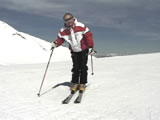Transform Your Skiing
This is a tip to take your skiing to the next level. If you already are at the next level, this tip will help smooth turn transitions and give you full access to carving technique for shaped skis.
Any level skier can benefit. Even if you are long past the wedge stage, have a look at the wedge demonstrations and explanations so you can identify the difference between an expert skier and an intermediate. And remember, many skiers who think they are experts still have power-robbing wedge movements in the transitions of their turns.
The Wedge Blocker will eliminate any such wedge movements. This is important, as even the slightest edge set at the bottom of a turn initiates a push-off, or wedge movement. Experts who feel they have hit a plateau are often victims of this phenomenon. Intermediate skiers will immediately raise their skiing levels with the wedge blocker turn.
Be aware, however, that this turn may not be immediately accessible to you if you lack certain abilities in your skiing. You can try it on your own, but if unsuccessful, there will be specific abilities you will need to develop first, before you can successfully make a Wedge Blocker Turn.
For example, you’ll notice in the photo sequences below that you must be able to balance on your little toe uphill ski edge at the beginning of the Wedge Blocker Turn. This is one of the crucial skiing skills you must possess if you are to progress rapidly. And if you discover you cannot do this, why not?
There are many possible reasons: Perhaps no one has told you this was an important skiing skill, so you never practiced it. You may have an alignment problem with your boots (likely). You may need to work on one footed balance.
There are different approaches to developing the Wedge Blocker Turn, which has many levels of proficiency. The one I demonstrate here is the basic turn:
Let’s begin by understanding the wedge and the problems it creates in effective skiing.
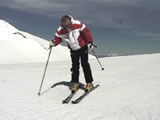 |
The wedge is the move that gets skiers in trouble.
This is a movement you likely were taught when you first learned to ski and it was probably reinforced as you continued to ski. Notice how all my weight is still on the lower ski, which has to be on edge to perform this movement. |
|
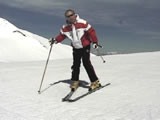 |
This opening move of the uphill ski is exactly the opposite of what true experts do, but even many experts exhibit a wedge opening in their turns, especially those who haven’t upgraded their technique. Even a slight opening between turns interrupts your move from turn to turn, robbing you of power and smooth transition to the next turn. | |
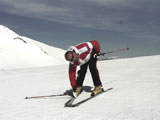 |
This is the ski and edge beginners stand on when they make wedge turns or wedge entries to turns. In this series you will learn to get rid of this nasty habit. | |
|
Examples of wrong movements from the lower edged ski |
||
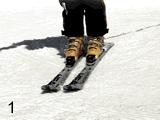 |
Notice in the animation (1 – 4) how the lower ski is weighted and edged so that the upper ski can be moved away. This is an example of what is taught to beginners in traditional skiing. You may still have this old habit, however refined or hidden it may be in your technique, and if you do, it is still doing damage. Like a computer virus, it will come back and ruin your skiing, like a virus will ruin your computer at the most inopportune times.
Once the upper ski is on the snow and weighted, the normal reaction is to bring the skis back together again as quickly as possible (5-8). The damage is already done in the first movements of this series—it’s too late to save this turn. |
|
|
Here are the first steps in learning to break the wedge turn-entry habit: |
||
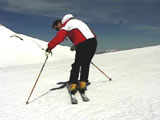 |
Let’s look at all this from another angle to see what can be done to cure the ailment.
Notice that both skis are on edge, angled to the snow.
|
|
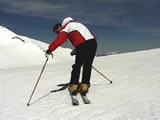 |
Lift the lower ski slightly to effect a weight change to the upper ski. The stance on the upper ski should now be completely on the little toe side upper edge. Shift back and forth to this position a number of times, to become familiar with the movement. This is the first step toward the anti wedge move (wedge blocker). | |
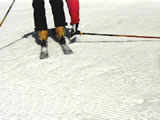 |
I’m pointing to the edge you should be standing on. | |
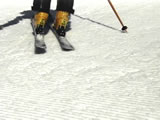 |
This is another example of the edge you should be standing on.
Both skis are on edge and angled.Notice that if you are standing on this edge you will not be able to stem or flare the uphill ski. If you are standing on the upper ski, it is locked to the ground. |
|
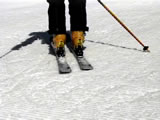 |
Learn to rock or hinge from the angled skis using both or individual foot and leg actions.
Use your pole to help maintain balance as you practice this movement from a standing static position. |
|
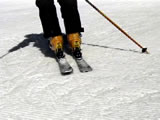 |
Both skis hinge, or rock, from an angled position to flat. | |
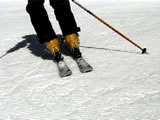 |
The skis are now coming to a new set of edges. | |
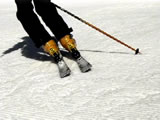 |
The lower ski is tipped more aggressively—allow the upper ski to follow the lower ski.
Avoid driving the action to the new edge with the upper ski. |
|
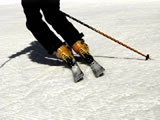 |
Continue the move, increasing tipping actions of the lower ski. | |
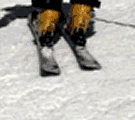 |
This animation shows the entire sequence | |
|
Try to achieve ever higher angles while perfecting this exercise. |
||

